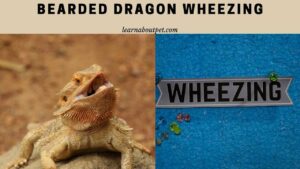Many people ask the question, why is my bearded dragon often wheezing? New owners ask this type of question because they are not much familiar with bearded dragons. They show uncanny behavior if there is something wrong with normal life. You will see signs of many health issues when there is something wrong.
Why is a bearded dragon wheezing? The wheezing sign is because of the respiratory infection. To give your bearded dragons the best care, there are preventive measures like temperature and humidity monitoring. These things should be at optimum. Consult with your vet in case of any emergency.

This article will discuss bearded dragon wheezing, causes, and preventive measures for wheezing, and bearded dragon respiratory infection home treatment. Let’s dive into the details of bearded dragon wheezing.
What Does It Mean When Your Bearded Dragon Is Wheezing?
When the bearded dragon is wheezing, then there are chances of respiratory infection. When there is any problem with the respiratory tract, then your bearded dragon may start wheezing. Many other symptoms are also due to respiratory infections like open mouth inhalation, snorting, gasping. If there is runny mucus in the mouth, this may also be due to respiratory tract issues.
How Do I Know If My Bearded Dragon Has A Respiratory Infection?
A respiratory infection can be due to multiple things like parasites, fungi, viruses, and bacteria. The affected bearded dragon may sneeze. It may have discharges from the nose or eyes. It can be in the form of bubbles. There are many other symptoms like lethargy, loss of appetite, open mouth breathing, and shallow breathing.
Why Is My Bearded Dragon Making Breathing Noises?
When there is excess mucus in the mouth of a bearded dragon, then it may result in breathing noise. If the bearded dragon is breathing and voice is not like a normal breathing voice, it may be due to infection in the upper respiratory tract. You will also notice the thick strings in the bearded dragon’s mouth because of the mucous.
Why Is My Bearded Dragon Wheezing After Eating?
Bearded dragon wheezing after eating is normal. This condition happens when the bearded dragon eats a lot of food; they show this behavior. They don’t rely on bacteria and acids for the digestion of food. Digestion of food depends upon the heat from the environment. That is why proper heat and light are required for a bearded dragon to digest food properly.
Bearded dragons go for basking after eating; it is because of the proper digestion. In this period, the breathing rate changes. In many cases, breathing is very heavy. You need not worry about this because when they are breathing heavily, they are at normal behavior. This is because of food digestion.
Keep in mind that if you want to save the bearded dragon from this issue, you should prepare food for beardies correctly. Cut the food into small pieces or chop it well. Piece of food should not be larger than the space that is between two eyes.
Is It Normal For Bearded Dragons To Wheeze?
The respiration rate must be between six to ten times per minute. But this rate is not when they are running or exercising. Bearded dragon doesn’t breathe deeply. When they are in sleep, their breathing cycle drops three to four times per minute.
What Are Reasons Of Bearded Dragon Respiratory Infection Noise?
The hissing sound is also when the bearded dragon is upset. There are many other symptoms like color changes, body flattening, beard puffing, head bobbing and leg waving, etc. these symptoms tell us that a bearded dragon is not okay. There is something bad. You need to find the problem and make the best solution.
Respiratory infection is a common problem in many reptiles, like bearded dragons, in dirty or unsanitary environments. When there is not optimum humidity level, then bearded dragons may get respiratory issues. There are multiple reasons for respiratory problems like vitamin A deficiency, illness, parasitism, and poor diet.
Why Bearded Dragon Wheezing After Bath?
A bearded dragon may start wheezing breathing. This can be because of stress. Bathing is not very good for bearded dragons because it can cause stress in bearded dragons. When they are in a stressful environment, they show signs like climbing frantically, black bearding, and heavy breathing.
Why Is My Bearded Dragon Gasping?
Gasping can also be due to a respiratory infection. When there is an infection, then bearded dragons may start gasping. You should consult with your vet in this situation. When a bearded dragon breathing heavy and opening mouth while breathing, it may be because of an infection in the respiratory tract.
What Is the Cause Of Bearded Dragon Squeaking Noise?
They were squeaking noises while breathing because of overeating. You should only feed that amount that the vets prescribe. There are different meal doses for different ages. When they eat too much in one sitting, then they may breathe abnormally.
There can be many other reasons for squeaking noise like
Stress
A bearded dragon’s respiratory system can be affected by stress. Bearded dragons are very susceptible to infection when exposed to a new environment or new things. Health issues may be due to several reasons, but stress is the leading cause of health issues in beardies. There is much other cause of respiratory problems in bodies like
- Noises
- Loud music
- Not proper lightening
- Improper handling
- Humidity
- Temperature of tank
- If there is more than one pet in the tank
- When they move to another location
Any of these things cause stress in bearded dragons. If you notice that a bearded dragon is breathing heavily, then you should know whether these factors are upsetting bearded dragons or not. You should find the problem and try to solve it.
You should consult with your vet if you don’t know the treatment of bearded dragons because the vet can be helpful for you in this regard. You are not sure what is going on with bearded dragons, but your vet can understand that is why vet consultation is the best way to treat your pet.
Respiratory Infection
When there is a high rate of heavy breathing in bearded dragons, it is a respiratory infection symptom. A respiratory infection can be dangerous for a bearded dragon’s life if left unchecked. Proper medication is required for this behavior.
A respiratory infection can be due to the following reasons
- When there is not the optimum temperature in the tank, then it may lead to respiratory infection
- Any disturbance in humidity level
- No proper ventilation in the habitat
- Unhealthy diet
- Infection from other animals in a habitat
- Lack of appetite
- Mouth mucus
- Mucous from the nose area
- Throat puffing
- Gaping
- Coughing
Heavy breathing happens normally after eating, but if it occurs more frequently, it can be because of a respiratory infection.
If above all signs are also, then you should consult with your vet as early as possible. It is because it can be fatal for bearded dragons and other animals in the tank.
What Are Preventative Measures For Respiratory Tract Infection
Reptiles like bearded dragons are very sensitive, and respiratory problems are very common. That is why you should know the preventive measures to save bearded dragons from infection.

Humidity
You should be well aware of the temperature and humidity level of bearded dragons. Any disturbance in these factors can lead to bearded dragon wheezing. Optimum temperature is the best for proper organ functioning.
If you want to reduce the respiratory infection risk, then the humidity level of the habitat should be between thirty to forty percent. If there is more than forty percent humidity level, then it can be dangerous for them. You can use many devices like a hygrometer to know the humidity level of that place.
Temperature
Temperature is another important thing that is worth considering if you want to save them from infections. Beardie requires both cold and warm sides because both temperatures are important for the digestion of food. You can use a heat emitter to make the habitat warm in case of low temperatures.
If there is an adult bearded dragon, then the temperature should be from 95 to 105 Fahrenheit. On the warm side of the tank, the temperature must be 85 Fahrenheit. Baby beardies require a slightly warm temperature as compared to adult bearded dragons.
Reduce Stress
Reducing stress can be helpful for you to reduce stress from the bearded dragon. Stress weakens the bearded dragon’s immune system that is why the bearded dragon gets a respiratory issue. When there is a weak immune system, the ability to defend the body against diseases may be lowered and result in various diseases.
Stress conditions can also be reduced by providing them with a good habitat. Optimum temperature is also necessary for bearded dragons.
Clean Environment
Proper cleanliness is required for the healthy lifespan of bearded dragons. If you provide proper sanitary conditions to them, then the chances of getting diseases will be minimal. Dirty habitat has bacteria, molds, and dirt that are the cause of respiratory problems. It would be best if you cleaned the tank once a month.
Why Bearded Dragon Wheezing After Drinking Water
Bearded dragon wheezing maybe after drinking, but this is only when the bearded dragon is suffering from a respiratory infection. You should provide them with good heat because it is important for proper functioning and digestion.
What Is Bearded Dragon Respiratory Infection Treatment Cost
The cost of treatment of respiratory infection depends upon the nature of the infection. If there is not a severe infection, you may treat them at home, but if the case is severe, there is a very high breathing rate with noises, so you should consult with your vet.
How To Treat Bearded Dragon Wheezing Problem?
Following are the treatment for bearded dragon wheezing issue
Elevate Cage Temperatures Gradually
You can increase the temperature of the cage or habitat in which bearded dragons are living. The rise in three to five-degree temperatures results in extra moisture absorption and makes the environment fit for them. Bearded dragon wheezing can be reduced by removing humidity.
The normal temperature of the habitat should be between 95 to 100, but this is on the warm side of the tank. The 85-degree temperature on the cooler side will be okay. For babies, the temperature should be 105 on the hot side and 110 on the cold side.
Elevate bearded dragon to Drain Mucus
You can elevate a bearded dragon to drain mucus. For doing this, you can elevate the beardie for about ten to fifteen degrees angle and let mucous drain from the throat. Bearded dragon wheezing is due to excess mucus in the mouth. This method is also helpful, and you can do this in-home also.
Use Dehumidifier
Bearded dragon wheezing can be controlled with a dehumidifier. If there is very much humidity in the tank or habitat and humidity is above forty percent, you should use a dehumidifier to remove excess humidity. When bearded dragons are in a more humid environment, there are more respiratory tract infections. This is expensive, but it can save bearded dragons from severe infection.
Use Fogger For Treatment
Fogger transforms liquid into vapors, and that can inhale directly into the lungs. In case of severe tract infection, fogger can be very beneficial because it can directly treat the lungs of beardies.
Visit Your Vet
Bearded dragon wheezing is dangerous because it can be because of severe infection. You should consult with your vet to treat them. As we know that they are very sensitive, self-medication is not good in the treatment of beardies.
Only a vet can diagnose and provide the best treatment. He will know the severity of the disease then prescribes the medication accordingly. The dose of medicine also depends upon the size of the bearded dragon.

Final Verdict On Bearded Dragon Wheezing
Bearded dragon wheezing is due to respiratory infection. You can also use preventive measures like reducing stress, cleaning the environment, removing humidity, and proper temperature. There are also many treatments of bearded dragon wheezing like a dehumidifier, use of fogger, and elevation of cage’s temperature.

Welcome to Learn About Pet. My name is Rajkumar Ravichandran and I love all pets, travel, and amazing food. I write about my passion and personal experience caring for multiple pets in this blog! ❤️
Post Disclaimer
DISCLAIMER: THIS BLOG OR WEBSITE, "Learn About Pet", DOES NOT PROVIDE YOU WITH MEDICAL ADVICE AND IS NOT A SUBSTITUTE FOR MEDICAL ADVICE. ALWAYS GET IN TOUCH WITH YOUR PERSONAL VETERINARIAN AND USE INFORMATION HERE AS GENERAL ADVICE.
The information, including but not limited to, text, graphics, images and other material contained on this website are for informational purposes only. No material on this site is intended to be a substitute for professional veterinary advice, food recommendation, diagnosis, or treatment. Always seek the advice of your veterinarian or other qualified health care provider with any questions you may have regarding a medical condition or for pet food related questions.







